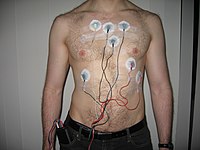
Photo from wikipedia
Vital signals monitoring is expected to support people in their daily activities in the near future, following continuous strides in developing health technologies for complex and hazardous environments. As the… Click to show full abstract
Vital signals monitoring is expected to support people in their daily activities in the near future, following continuous strides in developing health technologies for complex and hazardous environments. As the industry 4.0 revolution grows, robotic systems are increasingly deployed to support health monitoring, even though current robotic systems merely enable navigation and exploration of the surrounding environment to find people to be monitored, without adaptation of their behaviour to improve the quality of the health monitoring. At the European Organization for Nuclear Research (CERN), a wireless personnel safety prototype has been developed to assist workers in harsh environments, although this system needs to be improved in terms of invasiveness and portability. This work proposes a novel contactless approach based on a robotic system that adapts its behaviour to improve the performance of imaging-based algorithm for continuous physiological monitoring. Specifically, cardiac activity is monitored from camera views to obtain non-invasive and reliable vital parameter measurements. An extensive experiment has been conducted with ten healthy volunteers. The participants’ heart rates were monitored at different distances and different camera zoom levels from the robotic system, and synchronously measured by a heart rate benchmark device for the ground truth. The results highlighted several distance-zoom combinations that can be reached by the robotic system to adapt its behaviour to the boundary conditions in order to minimize the heart rate measurement error during algorithm calculations. These distance-zoom combinations are used to implement the control of the robotic system, improve the heart rate calculation algorithm and overcome the limitations of previous systems. A comparison with previous works in the literature involving the cardiac activity algorithm reveals a consistent contribution of the robot-assisted contactless monitoring system in reducing the mean absolute error in heart rate estimation.
Journal Title: IEEE Access
Year Published: 2022
Link to full text (if available)
Share on Social Media: Sign Up to like & get
recommendations!